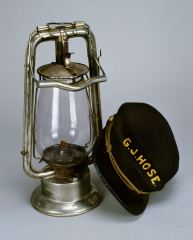

By 1902 the town hired its first crew of three professional firemen, with horses to pull a fire engine. Volunteer firemen were still available, however, and this cap was worn by a member of Hose Company #1. The oil lantern was necessary before electric lights became common.
The 1900s
Grand Junction by 1900 had evolved from a simple frontier town to a small city with
advantages normally only found in
much larger communities. This set the pattern that continues. The 1900
Federal Census recorded a Grand Junction population of 3,503, a 72.6 percent
gain over the previous decade.